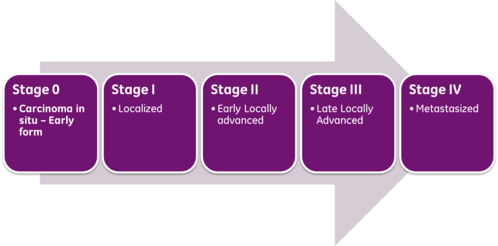When the malignancy of cancer has spread but is still within the primary site, what stage is it in?
1 Answer
Depends what the primary site is..
Explanation:
There are several Cancer Staging Systems in use. The most widely used is the TNM staging system: Tumor/Node/Metastasis .
This staging system is regularly updated, jointly by the American Joint Committee on Cancer (AJCC) and the Union for International Cancer Control (UICC). The version of the latter is considered the "universal" one...
The question is simple, the answer more complicated:
T, N and M are Categories used in the definition of stages. The definitions are slightly different for each category:
T (Tumor) category:
TX: Tumor unknown, or cannot be assessed.
T0: No evidence of Primary Tumor.
T1, T2, T3, T4:: indicates the extent of the increase in size of the (primary) tumor.
N (Regional Lymph Node) Categories:
NX: No info.
N0: No regional lymph node involvement .
N1, N2, N3:: Evidence of regional node(s) containing cancer (size, number involvement)
M (Distant Metastasis) Categories:
M0: No evidence of (distant) metastasis;
M1: Evidence of distant metastasis;
Observe that there is no MX defined;
Use of TX and NX should be minimised.
These categories together form the Stage:

e.g. in pancreatic cancer, classification T4 NX M0 would fall in Stage III.( T4 = (very) advanced primary tumor, NX = no info about Lymph Node involvement, M0 = no (detectable) metastasis...
To complicate things further, there is often a prefix added, to indicate the classification:
cTNM = clinical;
pTNM = pathological;
ycTNM and ypTNM = Posttherapy or Post Neoadjuvant
rTNM = recurrent;
aTNM = autopsy;
Apart from this ubiquitous TNM system, there are a few other staging systems, e.g. Ann Arbor staging, Cotswolds staging (modified Ann Arbor Staging), Dukes Staging, FIGO system , etc. These are usually modifications of the TNM-system for specific organs. (e.g. Ann Arbor, for Lymphoma).
SO, to go back to the question : Probably any combination with T and N, as long as M = M0......

